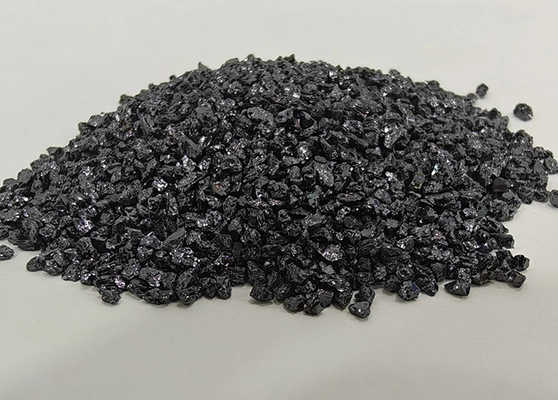Quick Answer: Chrome Alumina is a fused alumina (Al₂O₃) doped with small amounts of chromium oxide (Cr₂O₃). The chromium gives it a distinctive pink to ruby-red color, improved toughness, and excellent thermal stability. It is widely used in precision grinding wheels for tool steels, kiln refractories, and synthetic ruby gemstones for lasers and optics.
Understanding Chrome Alumina
Chrome Alumina is produced by fusing high-purity alumina with chromium oxide in an electric arc furnace. Depending on the chromium level, it appears light pink (low Cr₂O₃) to deep ruby red (high Cr₂O₃). In industry, it is marketed as Pink Fused Alumina or Ruby Alumina. Its combination of hardness, toughness, and thermal stability makes it ideal for precision abrasives and refractory applications.
Key Properties & Parameters
| Property | Chrome Alumina | White Fused Alumina | Brown Fused Alumina |
|---|---|---|---|
| Color | Pink → Ruby Red | White | Brown |
| Cr₂O₃ Content | 0.1–3% | — | — |
| Mohs Hardness | ≈ 9 | ≈ 9 | ≈ 9 |
| Toughness | Higher than WFA | Sharp, brittle | Strong, less sharp |
| Main Uses | Precision abrasives, refractories, ruby gems | High-purity grinding, blasting | Heavy-duty grinding, refractories |
Manufacturing Routes & Forms
- Electric arc fusion of calcined alumina + Cr₂O₃ additives.
- Cooling & crushing into blocks → crushed, milled, classified.
- Macrogrits (F12–F220), micropowders (F230–F1200), aggregates for refractories.
- High-Cr₂O₃ growth → synthetic ruby crystals (gemstones, lasers).
Applications & Examples
1. Precision Abrasives
Chrome Alumina is especially valued in toolroom grinding wheels for hardened steels, stainless steels, and high-speed steels. Example: cylindrical grinding of HSS cutting tools, surface grinding of dies and molds, and sharpening drills and end mills. Compared to WFA, it gives better form-holding and wheel life.
2. Refractories
Thanks to its toughness and thermal stability, Chrome Alumina is used in kiln furniture, slide gate plates, and high-wear linings. Example: furnace linings for steelmaking ladles where spalling resistance is critical.
3. Synthetic Ruby & Optics
High-Cr₂O₃ alumina produces ruby crystals, used in jewelry, solid-state lasers, and high-end optical windows. Example: ruby laser rods (Cr³⁺:Al₂O₃) for precision instruments.
4. Specialty Ceramics
Chrome Alumina powders are also applied in wear-resistant coatings, spray powders, and advanced ceramic parts. Example: thermal-spray coatings for pump components exposed to abrasive slurries.
Selection Checklist
- Define application (abrasive wheel, refractory lining, gemstone).
- Specify chromium content (pink ≈0.2–0.5%; ruby >1%).
- Choose grit size (FEPA F or JIS standard).
- Request COA: Cr₂O₃ %, bulk density, PSD, toughness test.
- Confirm logistics: 25 kg bags, jumbo bags, palletization.
Comparisons & Procurement Points
| Type | Pros | Cons | Example Use |
|---|---|---|---|
| Chrome Alumina | High toughness, pink/red color, good thermal stability | Higher cost | Grinding hardened steels, kiln linings, ruby lasers |
| White Fused Alumina | High purity, sharp cut | Brittle, shorter wheel life | Polishing, precision blasting |
| Brown Fused Alumina | Economical, very tough | Lower purity | Heavy-duty grinding wheels, refractory bricks |
Procurement Tip: For toolroom wheels, Pink Chrome Alumina is ideal; for refractories, Ruby Alumina with higher Cr₂O₃ is preferred.
FAQs
Why is Chrome Alumina pink or red?
Because chromium oxide (Cr₂O₃) replaces some Al³⁺ in the lattice, giving pink to ruby-red coloration.
Is Chrome Alumina harder than White Alumina?
Hardness is similar (~Mohs 9), but Chrome Alumina has higher toughness, so grinding wheels last longer on steels.
What’s the difference between Pink and Ruby Alumina?
Pink Alumina has low Cr₂O₃ (~0.2–0.5%), Ruby has higher (>1%), making it deeper red and suitable for ruby gems and lasers.
Where is Chrome Alumina most cost-effective?
In grinding high-speed steel tools and in refractory linings subject to high wear, where its toughness offsets the higher price.
References
- ASM Handbook – Ceramics and Glasses, Cr-doped alumina abrasives.
- FEPA abrasive standards for fused alumina grit sizes.
- Materials science literature on ruby lasers (Cr³⁺:Al₂O₃).
- Industrial datasheets from fused alumina suppliers (WFA, BFA, Pink Alumina).
